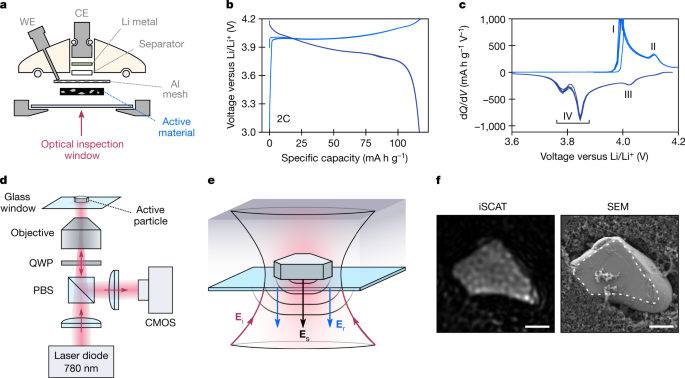Nature published a new paper describing what could become an important tool for improving battery technologies: a better way to observe what's happening inside the battery, in real time.

 www.nature.com
www.nature.com

Operando optical tracking of single-particle ion dynamics in batteries - Nature
The dynamics of ions within a working lithium-ion battery are examined using optical interferometric scattering microscopy, which allows ion transport to be related to phase transitions and microstructural features.
Abstract
The key to advancing lithium-ion battery technology—in particular, fast charging—is the ability to follow and understand the dynamic processes occurring in functioning materials under realistic conditions, in real time and on the nano- to mesoscale. Imaging of lithium-ion dynamics during battery operation (operando imaging) at present requires sophisticated synchrotron X-ray1,2,3,4,5,6,7 or electron microscopy8,9 techniques, which do not lend themselves to high-throughput material screening. This limits rapid and rational materials improvements. Here we introduce a simple laboratory-based, optical interferometric scattering microscope10,11,12,13 to resolve nanoscopic lithium-ion dynamics in battery materials, and apply it to follow cycling of individual particles of the archetypal cathode material14,15, LixCoO2, within an electrode matrix. We visualize the insulator-to-metal, solid solution and lithium ordering phase transitions directly and determine rates of lithium diffusion at the single-particle level, identifying different mechanisms on charge and discharge. Finally, we capture the dynamic formation of domain boundaries between different crystal orientations associated with the monoclinic lattice distortion at the Li0.5CoO2 composition16. The high-throughput nature of our methodology allows many particles to be sampled across the entire electrode and in future will enable exploration of the role of dislocations, morphologies and cycling rate on battery degradation. The generality of our imaging concept means that it can be applied to study any battery electrode, and more broadly, systems where the transport of ions is associated with electronic or structural changes. Such systems include nanoionic films, ionic conducting polymers, photocatalytic materials and memristors.
Merryweather, A.J., Schnedermann, C., Jacquet, Q. et al. Operando optical tracking of single-particle ion dynamics in batteries. Nature 594, 522–528 (2021). https://doi.org/10.1038/s41586-021-03584-2


